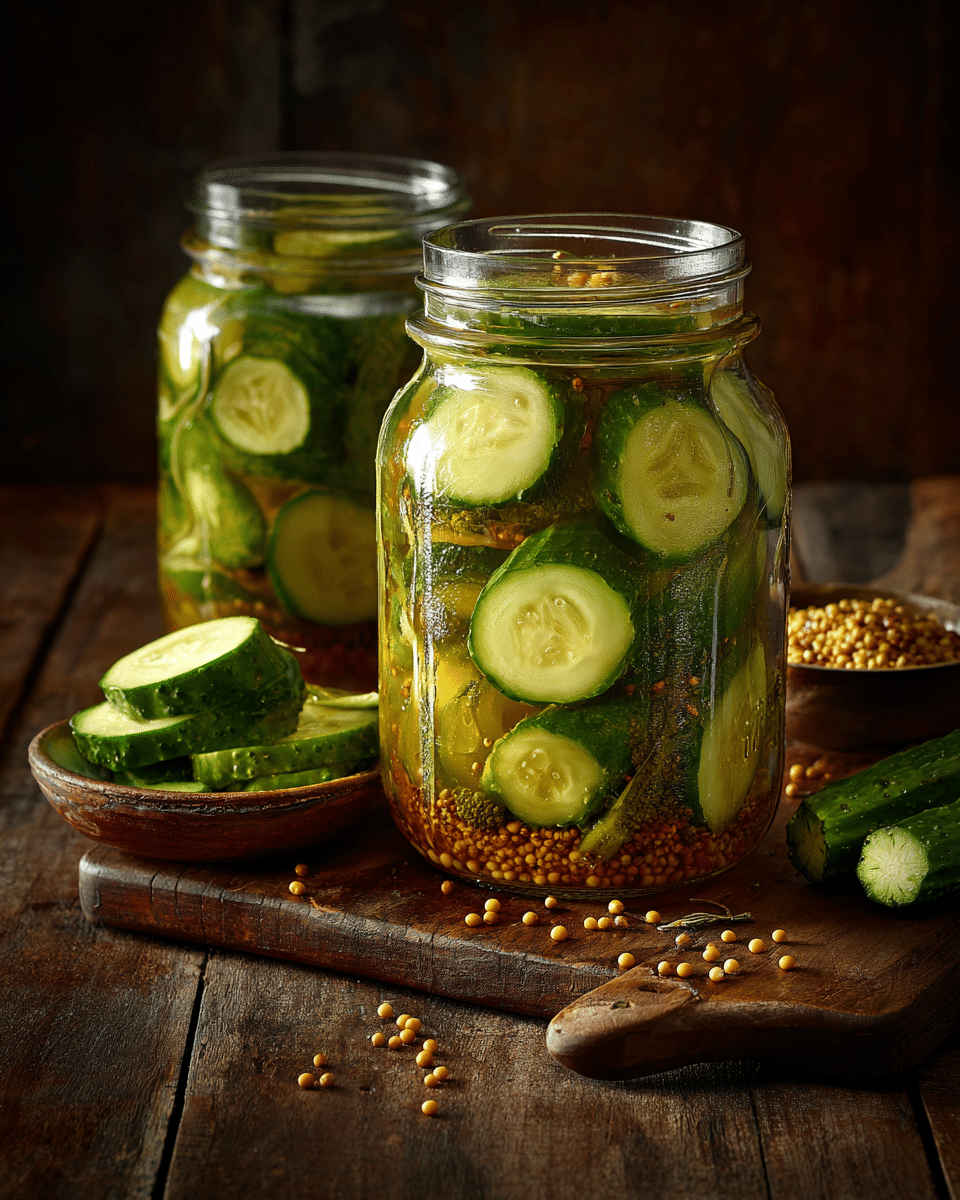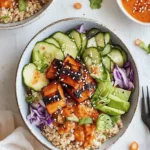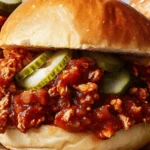Bread and butter pickles are a sweet and tangy favorite, perfect for burgers, sandwiches, or snacking right from the jar. This quick version comes together in just 30 minutes and requires no canning, making it ideal for beginners or anyone short on time. The result is crisp, flavorful pickles with a delightful balance of sugar and vinegar, accented by classic spices like mustard seeds and turmeric.
FULL RECIPE
Ingredients
- 4 cups thinly sliced cucumbers (about 3–4 small cucumbers)
- 1 small onion, thinly sliced
- 1 tablespoon kosher salt
- 1 cup white vinegar
- 1/2 cup granulated sugar
- 1/2 cup apple cider vinegar
- 1 teaspoon mustard seeds
- 1/2 teaspoon celery seeds
- 1/4 teaspoon ground turmeric
- 1/4 teaspoon ground cloves (optional)
- 1/4 teaspoon crushed red pepper flakes (optional, for slight heat)
Directions
- In a large bowl, combine the sliced cucumbers and onions. Sprinkle with kosher salt, toss to coat, and let sit for 10 minutes.
- While the cucumbers are resting, prepare the pickling brine. In a saucepan over medium heat, combine the white vinegar, apple cider vinegar, sugar, mustard seeds, celery seeds, turmeric, and optional spices. Stir and bring to a gentle boil until sugar is fully dissolved, about 5 minutes.
- Rinse the salted cucumber-onion mixture under cold water to remove excess salt, then drain well.
- Add the cucumbers and onions to the hot brine in the saucepan. Simmer for 5 minutes, stirring occasionally, until the cucumbers begin to turn olive green and slightly translucent.
- Using tongs or a slotted spoon, transfer the pickles and onions to clean glass jars or containers. Pour the hot brine over them, covering all vegetables.
- Let the jars cool uncovered at room temperature for about 15–20 minutes.
- Seal the jars and refrigerate. Pickles are ready to enjoy once chilled, typically within 30 minutes, but taste even better after a few hours.
- Store in the refrigerator for up to 2 weeks.
Nutrition Facts
- Calories: 45
- Total Fat: 0g
- Saturated Fat: 0g
- Cholesterol: 0mg
- Sodium: 320mg
- Total Carbohydrates: 11g
- Dietary Fiber: 0.5g
- Sugars: 10g
- Protein: 0.5g
- Vitamin C: 6% DV
- Calcium: 2% DV
- Iron: 1% DV
History of Bread and Butter Pickles
Bread and butter pickles have a charming origin story rooted in Southern American kitchens. The name is said to come from the simple, everyday pairing of these sweet and tangy pickles with bread and butter sandwiches. Originating during the Great Depression, this recipe offered an affordable way to preserve cucumbers and add flavor to meals. Over time, the pickles evolved from a humble homemade staple to a beloved condiment found on grocery store shelves nationwide.
Flavor Profile and Texture
The hallmark of bread and butter pickles is their distinctive balance of sweetness and acidity, which sets them apart from more sour or dill-based pickles. The inclusion of sugar and vinegar creates a bright, tangy flavor complemented by warming spices such as mustard seeds and turmeric. The quick pickling method helps retain a satisfying crispness in the cucumber slices, giving a refreshing crunch that enhances both texture and taste.
Health Benefits of Pickling
Pickling cucumbers offers more than just delicious flavor; it can also provide some health advantages. Cucumbers are naturally low in calories and rich in hydration. The vinegar used in pickling may support digestion and blood sugar regulation. Moreover, homemade quick pickles avoid the excessive preservatives and additives often found in commercial varieties, making them a cleaner, more wholesome choice. However, due to the sugar and sodium content, moderation is recommended.
Variations on the Classic Recipe
While the basic bread and butter pickle recipe is delicious on its own, there are numerous ways to personalize it. Some people add fresh dill for a hybrid flavor profile or experiment with spices like cinnamon or allspice for added warmth. Using different types of vinegar such as malt or red wine vinegar can also change the acidity and flavor complexity. For a spicy kick, crushed red pepper flakes or sliced jalapeños can be included. These variations allow home cooks to tailor the pickles to their taste preferences.
Serving Suggestions and Pairings
Bread and butter pickles are incredibly versatile and can elevate a wide array of dishes. They shine as a topping on classic deli sandwiches, burgers, and grilled cheeses, adding a sweet contrast to savory ingredients. They also work well chopped into potato salads or tossed into coleslaw for extra zing. Some enjoy them as a tangy side snack, straight from the jar. Their sweet and sour notes pair wonderfully with rich meats like pork or fried chicken, balancing heavier flavors with brightness.
Storage and Shelf Life
Quick bread and butter pickles, unlike traditional canned pickles, are refrigerated and have a shorter shelf life. When stored properly in airtight containers in the refrigerator, they usually last up to two weeks while maintaining their crispness and flavor. It’s important to keep them submerged in the brine to prevent spoilage. For longer storage, pickles should be made with proper canning techniques, but the quick recipe is designed for immediate use and convenience.
Nutritional Considerations
Though flavorful, bread and butter pickles contain notable amounts of sugar and sodium, which are essential to the pickling process and flavor. While they offer some vitamins and antioxidants from cucumbers and spices, they should be enjoyed as a condiment rather than a health food. Those monitoring blood sugar or salt intake should consume them sparingly. For a lower-sugar version, recipes can be adjusted by reducing sugar or using sugar substitutes, though this may affect texture and flavor.
Tips for Achieving the Perfect Crispness
Achieving crisp pickles is a common goal for many home cooks. Using fresh, firm cucumbers and slicing them thinly helps maintain a crunchy bite. Salting the cucumber slices before pickling draws out excess moisture, which prevents sogginess. Quickly cooking the pickles in hot brine rather than lengthy fermentation helps retain firmness. Finally, storing the pickles in the fridge rather than at room temperature slows the softening process and keeps them crisp longer.
Cultural Significance and Popularity
Bread and butter pickles hold a nostalgic place in American culinary culture. They evoke memories of home cooking, family picnics, and summertime harvests. Their sweet, mellow flavor appeals to many palates, especially those who prefer milder pickles. This recipe has also influenced commercial pickle production, inspiring many store-bought varieties that aim to replicate the homemade taste and texture. Their enduring popularity is a testament to their approachable flavor and ease of preparation.
Common Mistakes to Avoid
One common mistake when making quick bread and butter pickles is not adequately salting and draining the cucumbers before pickling, which can lead to watery or bland pickles. Another is overheating the brine too aggressively, which can cause the cucumbers to soften too much. Using old or overripe cucumbers will also affect texture negatively. Finally, failing to keep the pickles submerged in the brine during storage may result in spoilage or uneven flavor distribution.
Conclusion
Bread and butter pickles are a delightful and accessible way to enjoy the fresh taste of cucumbers with a perfect blend of sweetness and tang. Their quick preparation and adaptability make them a favorite for both novice and experienced cooks. Whether used as a sandwich topper, a side dish, or a snack, they bring vibrant flavor and satisfying crunch to any meal. By understanding their history, health aspects, and storage tips, you can confidently create and enjoy this classic pickle recipe anytime.






